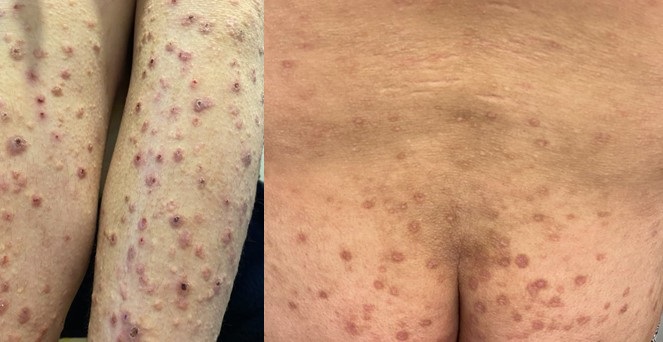Research & Publications > The Hong Kong Practitioner > Clinical Quiz

Clinical Quiz (Please login 'Member Area' for online submission of latest issue)
Clinical Quiz June 2022
A teenage boy presented with sudden onset of an itchy rash over the body and bilateral limbs
Sze-man Wong
|
Readers are invited to participate in the Clinical Quiz*. Simply answer the question, fill in the reply slip and return it to the College by 17 August 2022. Each reader is allowed to submit one entry only. The name of the winner and the answer will be published in the September 2022 issue.
*Note: There would be no prize award for this issue while sponsorship for Clinical Quiz has been ended in September 2020 issue. The answer of the Clinical Quiz for this issue will be announced in the next issue. Thank you for your support.
|
Clinical history:
A teenage boy presented with sudden onset of an itchy rash over the body and bilateral limbs. He denied any fever, sore throat, systemic upset or insect bites. He has no history of drug allergy, a recent new drug or food intake. He has his vaccination up to date.
What is the diagnosis?
| A. | Chickenpox (varicella) |
| B. | Pityriasis lichenoides et varioliformis acuta |
| C. | Lymphomatoid papulosis |
| D. | Disseminated herpes simplex virus infection |
Answer:
B. Pityriasis lichenoides et varioliformis acuta
Pityriasis lichenoides et varioliformis acuta (PLEVA), also known as Mucha -Habermann disease, is an uncommon skin inflammatory disorder which affects young adults and children. The incidence or prevalence is not known. There is a slight male predominance. The pathogenesis of PLEVA is poorly understood and is hypothesised as an aberrant immune response to viral, bacterial or protozoal infection, such as human herpesvirus 8, Epstein Barr virus, group A streptococcus and toxoplasma gondii. In keeping with the infective theory, PLEVA could represent a clonal immunologic response to a microbial antigen. Cases of development of PLEVA soon after receiving vaccines have been reported, such as live-attenuated measles vaccine, combined measles, mumps and rubella vaccine and influenza vaccine. There are reports of PLEVA after immunomodulatory therapy such as pembrolizumab. In this case, the boy received one dose of the COVID-19 vaccine a few weeks ago.
Clinically, it usually presents as an acute onset of inflammatory papules that rapidly develop into haemorrhagic or necrotic crusted red-brown papules on the skin. The trunk, proximal extremities, and skin flexures are the most common site for involvement. Mucosal involvement is typically absent. Hypopigmentation and hyperpigmentation frequently persist after lesion resolution. Systemic symptoms are often absent, although a minority may have fever and arthralgia. The median duration of PLEVA was 18 months, running a relapsing and remitting course before complete resolution.
A skin biopsy is required to confirm the diagnosis and rule out other disorders. Immunohistochemical studies show CD8+ T lymphocytes infiltrate the papillary dermis, but CD30 stain is usually negative. Lymphomatous papulosis (LyP) is a disease which closely resembles PLEVA. Patients present with recurrent crops of inflammatory papules and small nodules that regress spontaneously within a few weeks. In contrast, histologic and immunohistochemistry show atypical cells and CD30+ cells.
Varicella is the acute development of papulovesicules on multiple areas of skin; the lesions,
often described as a dewdrop on a rose petal, are caused by the Varicella zoster virus. Pruritus is usually present, lasting only one to two weeks. Especially in the elderly or immunosuppressed, patients may develop disseminated varicella. Polymerase chain reaction (PCR) or direct fluorescent antibodies (DFA) can be used to confirm the diagnosis.
In Patients with a history of compromised skin barriers such as atopic dermatitis, herpes simplex virus (HSV) infection may result in widespread vesicles, pustules and crust. PCR or DFA testing can be used to identify HSV.
In our case, skin swabs were done over the active skin lesions to test for HSV & VZV rapid viral culture and PCR, which were both negative. PLEVA is benign and usually self-limited with spontaneous resolution, but in some, it can cause cosmetically disfiguring scars and require treatment. Treatment for PLEVA includes topical corticosteroid, roughly 2-3month antibiotics therapy, e.g. erythromycin and phototherapy as first-line treatment. In refractory cases, methotrexate is an treatment option.
His skin condition showed a fair response to topical corticosteroids and antihistamine. Phototherapy is offered to him but was not done due to tight school schedule.
The slide and the question were prepared by:
Dr Sze-man Wong, MBBS, MRCP(UK), MSc(London), FHKCP, FHKAM
Associate Consultant,
Division of Dermatology, Department of Medicine, Queen Mary Hospital, Hong Kong SAR.
Back
